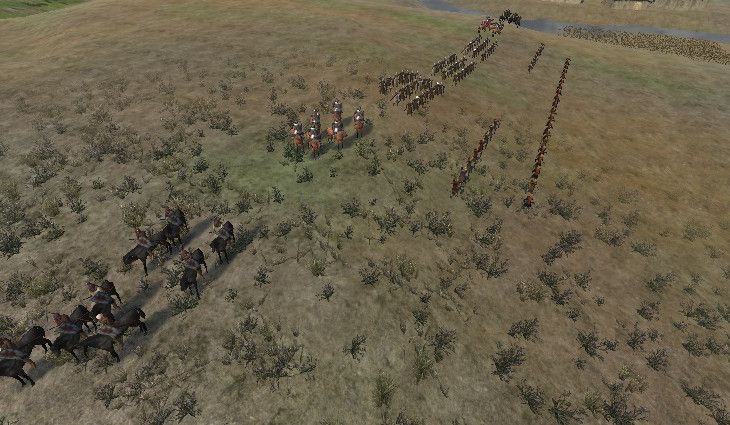
One thing I'd wanted to do is make field battles more interesting.
I've added a new battle mode that appears on a server when a player takes a mission from an NPC (another upcoming feature) and agrees to lead a battle. As you can see above, each army is divided into units (10, in this case) of similar troop types. Skirmishers are deployed in front, cavalry on the wings, and spearmen in the middle.
A player, instead of spawning his retinue, takes command of one of those units. The sponsoring player meanwhile can give overall battle commands to advance, fall back, skirmish or charge.
Only one side -- the attacker -- receives an overall army commander. The defending army will react to the attacker's actions -- but players may still command individual units.
Tactics:
Many historical battles are difficult to simulate in a game because they depended on commanders knowing -- somehow -- that their enemy would make a fatal mistake, and exploit it.
The archetypal example would be Cannae, where Hannibal bet that the Romans would charge headlong into the center, and thought up a defense that exploit that. This is difficult to simulate in a game, because if you know the AI will always make the same sort of mistake, there's no challenge for the players.
More useful for the purposes of the game are battles like Waterloo or Hastings -- battles that were not won by a single stroke of genius, but by many small decisions. Wellington said he never took so much "fuss" over a battle as he did over Waterloo, riding up and down the field, seeing where his troops were likely to break, and reinforcing those, or where the enemy was vulnerable, and exploiting those opportunities.
The key qualities here are situational awareness and timing. You want to engagle the enemy in those windows of opportunity when your morale is peaking, and there's is dipping. Also, you want to know where your men can hold on a little longer, so you can take troops from those areas to hit the enemy where you can break a unit and deal a decisive blow.
The new field battles have a clear attacker and defender side. The player that initiates the battles as part of a quest commands the attacking army. He is put in the position of Napoleon at Waterloo, or William at Hastings -- trying to dislodge an enemy before night falls.
The sponsoring player -- the overall general -- can give general commands to the army, charging, holding, advancing, skirmishing, or falling back. These will impact the army's overall aggressiveness. All players -- including for the other side -- can also take individual units within the army, made up of a single unit type, and maneuver them about the battlefield.
Morale:
Key to both sides' morale are the formed units of spearmen that provide a perception of safety and stability. Formations of tightly-arranged look impressive, above and beyond their fighting strength.
In this game, each unit is anchored to one of three spear formations, and the wing formations are anchored by the center formations. The spear formation provides a mobile base, a sense of safety on the battlefield. However, the further the spear formation moves from its own starting point, the less secure it feels.
The sense of security that a spear formation derives from staying near its own camp gives the defender a powerful advantage. However, casualties will wear away this sense of security. The game is set up so that a defender may be able to repulse multiple assaults, but it will grow more fragile over time and in the end may still lose the battle -- as what happened at Hastings.
Each agent is given security from his or her formation, which is in turn anchored to another formation. If the threat overtakes security, fear increases. Eventually, units may fall back or panic.












